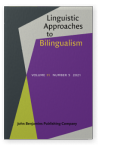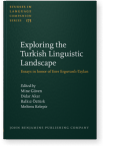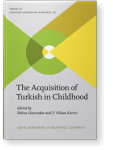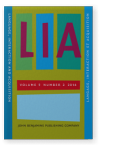Ayhan Aksu-Koç
List of John Benjamins publications for which Ayhan Aksu-Koç plays a role.
2021 Children’s thinking-for-speaking: Bidirectional effects of L1 Turkish and L2 English for motion events Linguistic Approaches to Bilingualism 11:5, pp. 669–699 | Article
This study investigates how children lexicalize motion events in their first and second languages, L1-Turkish and L2-English. English is a satellite-framed language that conflates motion with manner expressed in the main verb and path in a non-verbal element, whereas Turkish is a verb-framed… read more
2021 Chapter 11. Noun and verb derivations in early Turkish child and child-directed speech The Acquisition of Derivational Morphology: A cross-linguistic perspective, Mattes, Veronika, Sabine Sommer-Lolei, Katharina Korecky-Kröll and Wolfgang U. Dressler (eds.), pp. 263–288 | Chapter
This chapter presents the emergence of derivational morphology in nouns and verbs in the speech of two Turkish-speaking monolingual girls between the ages 1;3 and 3;0, taking into account the patterns in their child-directed speech. Derivational morphology emerges early, before age 3;0, although… read more
2016 The interface of evidentials and epistemics in Turkish: Perspectives from acquisition Exploring the Turkish Linguistic Landscape: Essays in honor of Eser Erguvanlı-Taylan, Güven, Mine, Didar Akar, Balkız Öztürk and Meltem Kelepir (eds.), pp. 143–156 | Article
Evidentiality marking is grammaticized in Turkish and closely aligns with the marking of epistemic notions. This paper addresses questions regarding the nature of evidentiality as a modal category, explores the functions of the evidential suffix -mIş/-(y)mIş for indicating information source and… read more
2016 Second language exposure in the preschool: Relation to first language skills and executive functions The Acquisition of Turkish in Childhood, Haznedar, Belma and F. Nihan Ketrez (eds.), pp. 389–412 | Article
An emerging situation in Turkey involves the acquisition of a second language (L2; English) in a context where the first language (L1; Turkish) is the majority language by children from advantaged social backgrounds. The present study explores the consequences of exposure to L2 in preschool on L1… read more
2014 Input offers and child uptakes: Acquiring mood and modal morphology in Turkish The role of input on early first language morphosyntactic development: Le rôle de l’input sur le développement morphosyntaxique précoce en langue maternelle, Kern, Sophie, Frédérique Gayraud and Florence Chenu (eds.), pp. 62–81 | Article
The present study examines input–output relations in the emergence of verbal affixes that mark modal distinctions in Turkish, a morphologically rich language. Longitudinal naturalistic speech data were analyzed from two girls between ages 1;3–2;6 and their caregivers. Four stages of development… read more
2014 Development of adjective frequencies across semantic classes: A growth curve analysis of child speech and child-directed speech Language, Interaction and Acquisition 5:2, pp. 185–226 | Article
This paper is a longitudinal investigation of adjective use by children aged 1;8−2;8, speaking Dutch, German, French, Hebrew, and Turkish, and by their caregivers. Each adjective token in transcripts of spontaneous speech was coded for semantic class. The development of adjective use in each… read more
2007 11. The (scarcity of) diminutives in Turkish child language The Acquisition of Diminutives: A cross-linguistic perspective, Savickienė, Ineta and Wolfgang U. Dressler (eds.), pp. 279–293 | Chapter
This study reports that diminutive morphology is not one of the early acquisitions in Turkish child speech (1;3–2;0), although the language has a number of productive diminutive morphemes. Similarly the use of hypocoristic forms of nouns is not a typical property of Turkish child speech. We… read more






